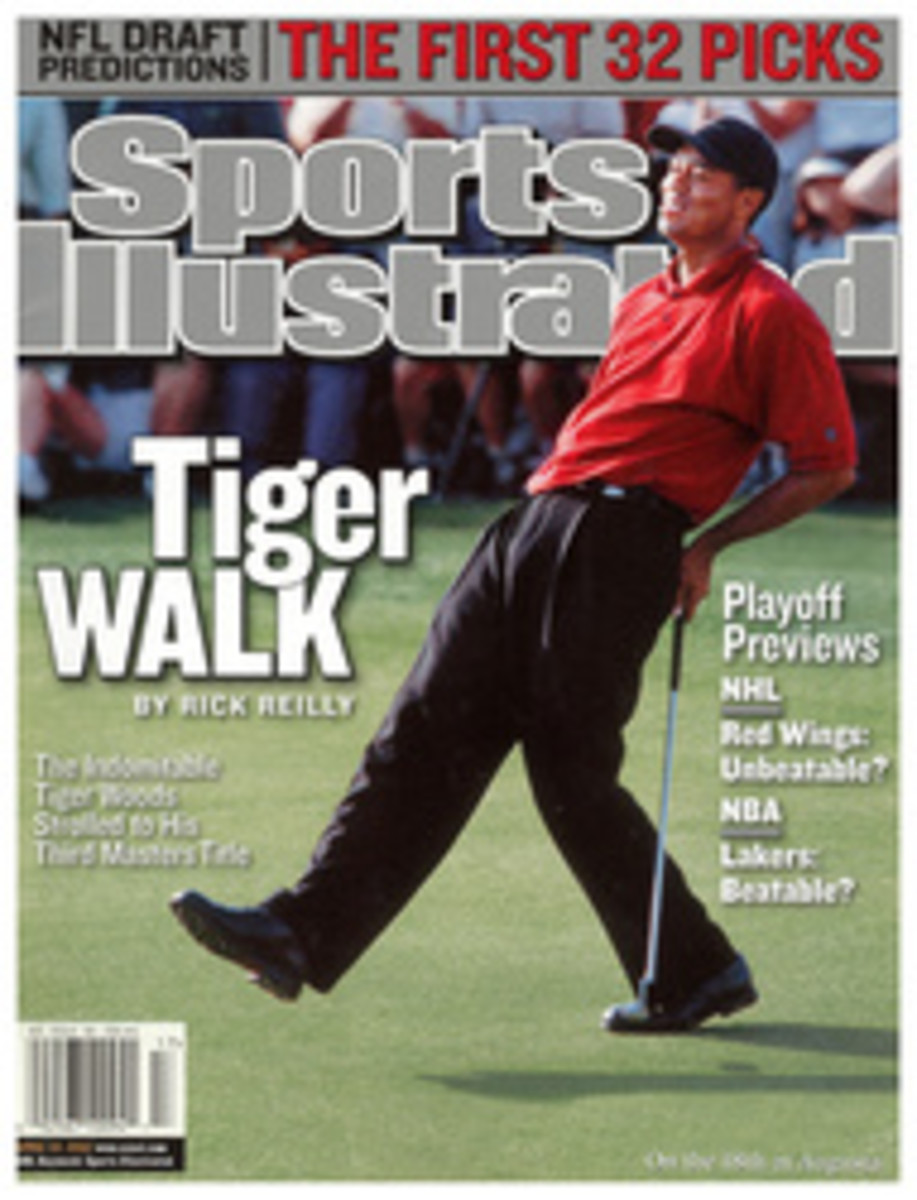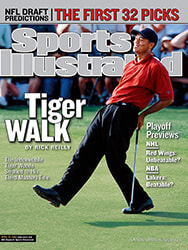
Different Strokes Augusta's radical overhaul caused headaches, notably at 9 and 18, but the big hitters prevailed
Padraig Harrington was seven under par and tied for fourth when he
stepped onto the 18th tee during the third round of the Masters.
Make a par, he figured, and wake up on Sunday morning as a
contender. Instead, Harrington hooked his drive under a pine,
punched a four-iron to the left of the green, pitched over the
putting surface and back into the fairway, chipped up to eight
feet, and two-putted for a double-bogey 6. Though Harrington
finished at five under, he was now tied for eighth, six strokes
behind the leaders, and he and everyone else knew there was no
way he was going to make up a half-dozen shots on a player like
Tiger Woods in a single day. "I would have been very happy with a
70 [he shot 72], but I can't undo what happened at 18,"
Harrington said afterward. "It was certainly easier last year,
when I hit lob wedge into that green every day."
Two hours earlier Jose Maria Olazabal had a similarly uneasy
feeling as he walked off the 9th green. Having played the first
eight holes in two over par, Olazabal, who'd begun the round at
five under, badly needed a birdie. Instead, he'd pulled his drive
into the trees, clipped a branch on his second shot, put his
third 18 feet from the hole and two-putted for another bogey.
Olazabal rallied on the back to finish at 71, but he too conceded
that he had no chance to win the tournament. "I was thinking I
should've stayed in bed," Olazabal said, describing his thoughts
following the bogey at 9. "That hole used to be a very good
birdie opportunity. It looks different to me now."
Different was the operative word last week at Augusta National,
thanks to the extra 300 yards parceled out among nine of the
holes this year, and the starkest differences were on the holes
that cost Harrington and Olazabal a shot at the green jacket.
Last year 9 and 18 ranked as the 10th and 13th most difficult
holes, respectively, but this year they jumped to third and
first. More important, the two holes added to the National's
character. And a championship-caliber course should finish with a
flourish.
Besides the extra real estate--the 18th hole was lengthened by 60
yards, to 465, and the 9th by 30, to 460--the two holes were among
the three (number 1 is the other) on which new trees were
planted, making them more difficult for golfers whose drives
strayed from the fairway. It was especially gratifying to see the
18th transformed so dramatically, for no hole had been rendered
so benign so quickly. In 1995 the 18th was the second-toughest
par-4 at Augusta, but by last year it was the second-easiest,
yielding more birdies (55) than bogeys (54).
According to The Augusta Chronicle, which charted every shot on
18 during the opening round, 17 of the 89 players hit their
drives into the trees on the left or the right, and only eight
hit a six-iron or less into the green. On Saturday the last 10
competitors played the 18th in a combined four over par. For the
week, the 18th ranked last among all holes in greens hit in
regulation (32.1%). "It's quite steep coming up the hill,"
Harrington said. "It's not like you're hitting four-iron from a
flat piece of ground. There's no water on the hole, but it still
bites."
The teeth looked sharpest from the back of the tee box. From
there, players had to hit accurate drives through a narrow chute
of trees--"like hitting up a gnat's ass," according to Greg
Norman. Before the hole was lengthened, players easily bombed
drives over the fairway bunkers on the left, which last year
caused Jack Nicklaus to suggest that the tee be moved to downtown
Augusta to make the hole more challenging. (In response to
Nicklaus's remark, someone hung a bronze marker reading downtown
on a tree behind the tee during a member's outing.) With the
bunkers now starting about 300 yards from the tee, most of the
long hitters were forced to lay up last week with three-woods. "I
talked to a lot of guys who played here in the 1970s, and that's
how they used to play the hole," said Tom Fazio, the course
architect who oversaw the changes. "Our idea was to make it so
only the long hitters could reach the bunkers."
With the fairways playing dry and hard earlier in Masters week,
before the rainstorms that first hit on Tuesday night, several
players suggested that shorter hitters might actually have an
advantage at 18. "It helps to have the bunkers so far out instead
of killing guys like me who hit it 275 yards," Scott Verplank
said after shooting a 70 on Thursday. That advantage was gone by
the second round, when the course was so saturated that no one
got any roll. Even with the tees moved up 30 yards, the 18th
ranked as the toughest hole on the course. "I'm worn out,"
Verplank said on Saturday after firing a 76 and dropping to 39th.
(He went on to finish 43rd.) "I'm not fond of hitting woods into
par-4s. If the course was hard and fast, a lot more guys would
have had a chance."
For all the talk of how the changes were meant to Tiger-proof the
course, the new-look Augusta ended up slaughtering the lambs.
"Look at that leader board, and try to find me a short hitter,"
said Nick Price on Friday afternoon. "Kind of backfiring on
everyone, isn't it?"
If Fazio sent the 18th back to the days of disco, he flat-out
Leave It to Beavered the 9th, which, as he pointed out, was
originally Augusta National's 18th before the nines were switched
in the fall of 1934. "Bobby Jones and Alister Mackenzie intended
the 9th to be a strong finishing hole with real character," Fazio
said. The hole's most distinguishing feature is the contour of
the right side of the fairway, where a small plateau is the only
flat landing area between two knolls. The flat spot is called
Hogan's Shelf because Ben Hogan liked to put his drives there. In
recent years, though, players would simply blow their balls down
the hill, leaving them a shorter approach--and a better angle--to
the bunkered, elevated green.
Last week the 9th fought back. Though the fairway was the easiest
to hit (84.5%), the green was the fourth-hardest to hold (46.0%),
trailing only the 14th (45.3%), the 10th (35.1%) and the 18th.
"You're forced to hit a draw off a downhill, slice lie,"
explained Tom Watson. A left-to-right wind made that even more
difficult on Thursday, when the 9th was the hardest hole on the
course (with a 4.352 field average). "A drive and pitching wedge
on that hole isn't in keeping with the designers' original
intent," Fazio said. "When Hogan played, there was a lot of
debate about whether those slopes on the fairway were unfair. We
wanted to bring them back into play."
Once again, when the course got wet and the balls got muddy, the
short hitters were at a disadvantage. "I've been saying all week,
'When they lengthened the course, they played into the hands of
the long hitters,'" said Olazabal, who bogeyed the 9th three out
of the four rounds. Rocco Mediate called the hole "just nasty,
total evil," adding, "I was in the fairway, holding a four-iron
and thinking, Where can I hit this ball so I can get it up and
down? I knew I couldn't hit the green." The most popular bail-out
spot was to the right. Said Ross Coughenour, who has worked the
9th hole as a gallery guard for more than a decade, "We had to
move the ropes over there more times this year than in my
previous 10 years combined."
Not surprisingly, the scoring averages increased on eight of the
nine holes that were lengthened, but only the 410-yard 7th, which
went from 14th-hardest last year to sixth this year, made a jump
comparable with the increases made by numbers 9 and 18. The two
par-5s that were lengthened, the 8th and the 13th, showed the
least amount of difference, though they did yield fewer birdies
and eagles (146 altogether, compared with 193 last year).
"This course has everything, and now it finishes very strong,"
Sergio Garcia said Sunday after coming in eighth at four-under
par. But the reviews were mixed on whether the new-look Augusta
will withstand the test of time. Asked on Sunday if he thought
the changes would continue to benefit big hitters, Garcia smiled
and said, "I want to play the course when it's nice and firm.
Then I'll tell you."
COLOR PHOTO: PHOTOGRAPHS BY ROBERT BECK Wedge no more Players who landed in the fairway on the toughened 18th still found themselves with a long iron to the green.
THREE COLOR PHOTOS: SIMON BRUTY (3) Barefootin' The 13th posed its own hazard for Stuart Appleby.
COLOR PHOTO: PHOTOGRAPHS BY ROBERT BECK Tough test An extended tee box helped transform 18 from the second-easiest hole on the course into the finisher Augusta deserved.
HOW THEY PLAYED
Last year, when Augusta measured 6,985 yards, the cumulative
average score was 72.493. This year the field averaged 73.445 on
a 7,270-yard-long course. Here's how Augusta's nine newly
lengthened holes played and ranked (1st being the toughest) in
2001 and in '02.
HOLE '01 AVG. RANK '02 AVG. RANK
1 4.209 2nd 4.151 10th
7 3.986 14th 4.200 6th
8 4.866 15th 4.936 15th
9 4.054 10th 4.226 3rd
10 4.231 1st 4.242 2nd
11 4.155 3rd 4.159 8th
13 4.740 17th 4.879 16th
14 4.014 12th 4.208 4th
18 4.014 13th 4.321 1st
The new-look Augusta ended up slaughtering the lambs. Said
Price, "Look at that leader board, and try to find me a short
hitter."

